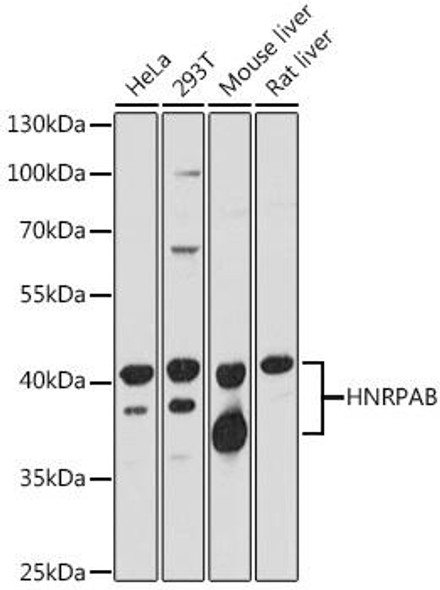Description
SLC33A1 Antibody (PACO18905)
The SLC33A1 Polyclonal Antibody (PACO18905) is specifically designed for research involving SLC33A1, a key protein involved in the regulation of cellular ceramide levels and sphingolipid metabolism. This antibody, generated in rabbits, exhibits high reactivity with human samples and has been validated for use in various experimental applications, including Western blotting.SLC33A1, also known as the Acetyl-CoA transporter 1, plays a crucial role in the transport of acetyl-CoA into the lumen of the Golgi apparatus for the synthesis of sphingolipids. Dysregulation of SLC33A1 has been implicated in various diseases, including neurodegenerative disorders and cancer.
Research into the functions and regulation of SLC33A1 is important for understanding its role in cellular homeostasis and disease pathogenesis.This antibody specifically targets the SLC33A1 protein, making it a valuable tool for researchers studying sphingolipid metabolism, lipid signaling, and related pathways. Its use in biochemical and cell biology research makes it ideal for investigations into the molecular mechanisms underlying various diseases and for the development of potential therapeutic interventions targeting SLC33A1.
| Antibody Name: | SLC33A1 Antibody (PACO18905) |
| Antibody SKU: | PACO18905 |
| Size: | 50ul |
| Host Species: | Rabbit |
| Tested Applications: | ELISA, WB |
| Recommended Dilutions: | ELISA:1:2000-1:5000, WB:1:500-1:2000 |
| Species Reactivity: | Human, Mouse, Rat |
| Immunogen: | Synthetic peptide of human SLC33A1 |
| Form: | Liquid |
| Storage Buffer: | -20°C, pH7.4 PBS, 0.05% NaN3, 40% Glycerol |
| Purification Method: | Antigen affinity purification |
| Clonality: | Polyclonal |
| Isotype: | IgG |
| Conjugate: | Non-conjugated |
 | Gel: 10%SDS-PAGE, Lysate: 40 μg, Lane: Mouse liver tissue, Primary antibody: PACO18905(SLC33A1 Antibody) at dilution 1/700, Secondary antibody: Goat anti rabbit IgG at 1/8000 dilution, Exposure time: 1 minute. |
| Background: | The protein encoded by this gene is required for the formation of O-acetylated (Ac) gangliosides. The encoded protein is predicted to contain 6 to 10 transmembrane domains, and a leucine zipper motif in transmembrane domain III. Defects in this gene have been reported to cause spastic paraplegia autosomal dominant type 42 (SPG42) in one Chinese family, but not in similar patients of European descent. Two transcript variants encoding the same protein have been found for this gene. |
| Synonyms: | solute carrier family 33 (acetyl-CoA transporter), member 1 |
| UniProt Protein Function: | SLC33A1: Probable acetyl-CoA transporter necessary for O- acetylation of gangliosides. Defects in SLC33A1 are the cause of spastic paraplegia autosomal dominant type 42 (SPG42). Spastic paraplegia is a neurodegenerative disorder characterized by a slow, gradual, progressive weakness and spasticity of the lower limbs. Rate of progression and the severity of symptoms are quite variable. Initial symptoms may include difficulty with balance, weakness and stiffness in the legs, muscle spasms, and dragging the toes when walking. In some forms of the disorder, bladder symptoms (such as incontinence) may appear, or the weakness and stiffness may spread to other parts of the body. Defects in SLC33A1 are the cause of congenital cataracts, hearing loss, and neurodegeneration (CCHLND). CCHLND is an autosomal recessive disorder characterized by congenital cataracts, severe psychomotor retardation, and hearing loss associated with decreased serum ceruloplasmin and copper. Brain MRI shows cerebral and cerebellar atrophy and hypomyelination. Belongs to the SLC33A transporter family. |
| UniProt Protein Details: | Protein type:Glycan Metabolism - glycosphingolipid biosynthesis - ganglio series; Membrane protein, integral; Transporter, SLC family; Membrane protein, multi-pass; Transporter Chromosomal Location of Human Ortholog: 3q25.31 Cellular Component: Golgi membrane; endoplasmic reticulum membrane; membrane; integral to plasma membrane Molecular Function:acetyl-CoA transporter activity; solute:hydrogen symporter activity Biological Process: proton transport; acetyl-CoA transport; transport; transmembrane transport Disease: Spastic Paraplegia 42, Autosomal Dominant; Congenital Cataracts, Hearing Loss, And Neurodegeneration |
| NCBI Summary: | The protein encoded by this gene is required for the formation of O-acetylated (Ac) gangliosides. The encoded protein is predicted to contain 6 to 10 transmembrane domains, and a leucine zipper motif in transmembrane domain III. Defects in this gene have been reported to cause spastic paraplegia autosomal dominant type 42 (SPG42) in one Chinese family, but not in similar patients of European descent. Two transcript variants encoding the same protein have been found for this gene. [provided by RefSeq, Jul 2010] |
| UniProt Code: | O00400 |
| NCBI GenInfo Identifier: | 74735319 |
| NCBI Gene ID: | 9197 |
| NCBI Accession: | O00400.1 |
| UniProt Secondary Accession: | O00400,B2R5Q2, D3DNK4, |
| UniProt Related Accession: | O00400 |
| Molecular Weight: | 549 |
| NCBI Full Name: | Acetyl-coenzyme A transporter 1 |
| NCBI Synonym Full Names: | solute carrier family 33 (acetyl-CoA transporter), member 1 |
| NCBI Official Symbol: | SLC33A1 |
| NCBI Official Synonym Symbols: | AT1; AT-1; ACATN; SPG42; CCHLND |
| NCBI Protein Information: | acetyl-coenzyme A transporter 1 |
| UniProt Protein Name: | Acetyl-coenzyme A transporter 1 |
| UniProt Synonym Protein Names: | Solute carrier family 33 member 1 |
| Protein Family: | Acetyl-coenzyme A transporter |
| UniProt Gene Name: | SLC33A1 |
| UniProt Entry Name: | ACATN_HUMAN |










